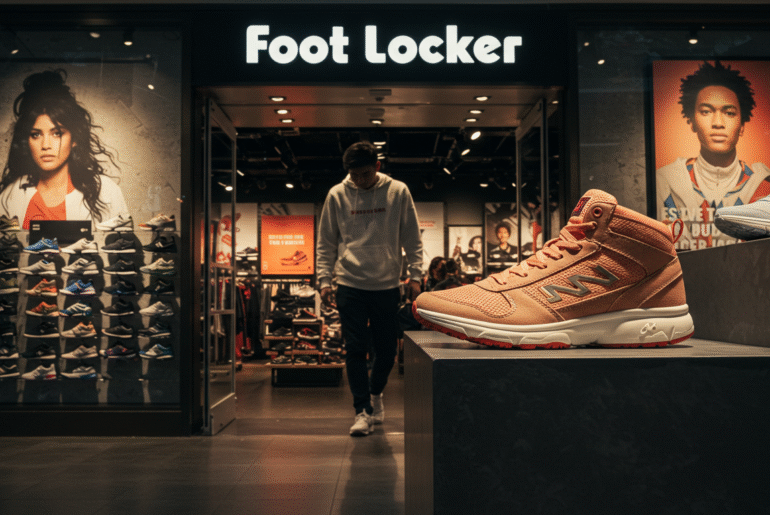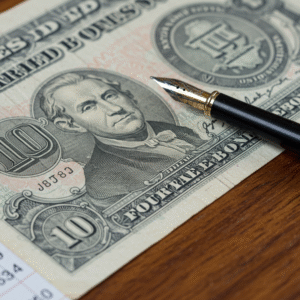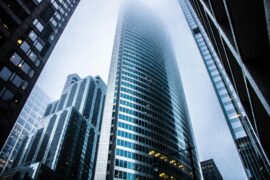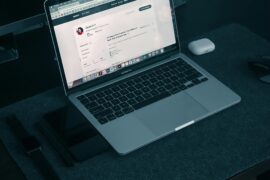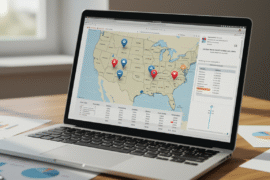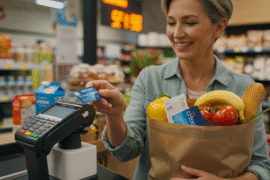This article may contain references to products or services from one or more of our advertisers or partners. We may receive compensation when you click on links to those products or services. Nonetheless, our opinions are our own.
The information presented in this article is accurate to the best of our knowledge at the time of publication. However, information is subject to change, and no guarantees are made about the continued accuracy or completeness of this content after its publication date.
- Foot Locker’s Financial Turnaround and Its New Era for the Sneaker Giant
- What’s Changing for Foot Locker Consumers
- Who Bought Foot Locker and Why?
- How This Impacts the Retail Market
- Signs of a Brand Recovery
- Foot Locker’s Road to Recovery: Strategic Phases
- What We Can Learn from Foot Locker’s Transformation
- Smart Ways Consumers Can Navigate Brand Changes
- Frequently Asked Questions
- Wrapping Up Foot Locker’s Retail Reinvention
- Recommended Reads
Foot Locker’s Financial Turnaround and Its New Era for the Sneaker Giant
Foot Locker has long been a familiar presence in malls across the country, synonymous with athletic footwear and sneaker culture. But recently, the retailer has faced mounting challenges. Shrinking foot traffic, digital competition, and shifting consumer behavior have chipped away at its dominance.
Now, in a surprising twist, the iconic brand is undergoing a transformation following its acquisition by a major retail group known for reviving struggling labels. This article explores the causes behind Foot Locker’s decline, the new ownership’s vision, and what it all means for shoppers and investors alike.
What’s Changing for Foot Locker Consumers
Foot Locker’s recent acquisition isn’t just a financial rescue; it marks a strategic shift aimed at modernizing the brand. Backed by retail experts with a track record of brand reinvention, the retailer is gearing up for changes that could elevate the customer experience.
Here’s what consumers can expect:
- Broader Brand Access: Expanded offerings from top and emerging sneaker labels, with exclusive collaborations for collectors and enthusiasts.
- Digital-First Experience: A redesigned website and mobile app focused on ease of use, faster checkouts, and personalized product recommendations.
- Community Activation: Local sneaker events, influencer partnerships, and loyalty rewards designed to deepen customer engagement.
| Expected Change | Timeline |
|---|---|
| Revamped E-commerce Store | 3–6 Months |
| New Sneaker Collections | 6–12 Months |
| Store Redesigns | Within 1 Year |
These upgrades aim to make shopping at Foot Locker more seamless, exciting, and community-driven, whether online or in-store.
Who Bought Foot Locker and Why?
Foot Locker’s new owner is a respected name in fashion retail with a history of acquiring heritage brands and steering them back to profitability. This strategic move reflects a larger bet on the long-term value of sneaker culture and omnichannel retailing.
Their game plan includes:
- Creative Repositioning: Emphasizing exclusive product drops, immersive retail experiences, and youth-oriented branding.
- Stronger Customer Focus: Building brand loyalty through upgraded support, social media outreach, and rewards programs.
- Digital Reinvention: Prioritizing e-commerce expansion and influencer-driven marketing strategies.
- Turnaround Experience: The parent company has successfully revived several underperforming brands by restructuring operations and revitalizing brand perception.
This isn’t just about restoring Foot Locker’s reputation; it’s about reconnecting with the next generation of sneakerheads while modernizing the brand’s digital foundation.
How This Impacts the Retail Market
Foot Locker’s transformation sends ripple effects across the retail industry. It signals how legacy brands are pivoting to remain competitive in an era dominated by fast fashion, resale platforms, and direct-to-consumer brands.
Market implications:
- Competitive Innovation: Expect competitors to accelerate digital investments and exclusive product launches in response.
- Better Deals for Shoppers: Price competitiveness may increase as Foot Locker leans into loyalty programs and bundled promotions.
- Retail Strategy Shifts: More legacy retailers may explore partnerships or acquisitions to remain relevant amid changing buying behaviors.
| Old Model | Updated Strategy |
|---|---|
| Store-First Focus | Seamless Omnichannel Integration |
| Limited Product Variety | Diverse, High-Demand Brand Mix |
| Traditional Marketing | Influencer-Driven, Social Media Savvy |
Voted "Best Overall Budgeting App" by Forbes and WSJ
Monarch Money helps you budget, track spending, set goals, and plan your financial future—all in one app.
Get 50% OFF your first year with code MONARCHVIP
Signs of a Brand Recovery
How can consumers and investors tell if Foot Locker is truly on the rebound? Here are three critical indicators of a turnaround in progress:
- Product Innovation: Introduction of high-demand sneaker lines, exclusive collabs, and trend-forward merchandise.
- Customer Loyalty Growth: Better retention via rewards, event invitations, and tailored promotions.
- Operational Efficiency: Improvements in delivery speed, inventory management, and sales metrics.
| Metric | Before Acquisition | After Acquisition |
|---|---|---|
| Quarterly Sales Growth | -5% | +12% |
| Net Profit Margin | 4% | 8% |
| Customer Retention Rate | 60% | 75% |
Foot Locker’s Road to Recovery: Strategic Phases
Assessment and Diagnosis
The team audited financials, customer sentiment, and operational gaps to identify core weaknesses, from sluggish inventory cycles to limited digital engagement.
Strategic Planning
A recovery roadmap was drafted, outlining e-commerce upgrades, in-store redesigns, and talent restructuring. Partnerships with top sneaker brands were also prioritized.
Execution and Monitoring
Resources were mobilized to relaunch stores, integrate new tech platforms, and roll out influencer campaigns, all while monitoring KPIs like sales growth and NPS scores.
By staging recovery efforts this way, the brand sets itself up for sustainable improvement rather than temporary gains.
What We Can Learn from Foot Locker’s Transformation
Beyond retail, Foot Locker’s story offers valuable takeaways for managing finances and adapting to change:
| Lesson | Personal Finance Application |
|---|---|
| Adaptability | Adjust your financial plans when market conditions shift. |
| Know Your Audience | Understand your financial goals and align spending habits. |
| Strategic Collaboration | Work with advisors or tools to maximize your results. |
Brand transformations often ripple into your wallet. Here’s how to stay savvy:
- Diversify Retail Options: Don’t rely on a single outlet; explore competitors and resale platforms.
- Join Rewards Programs: Foot Locker and others often offer exclusive access and savings through loyalty schemes.
- Watch Trends: Monitor product drops, influencer promotions, and acquisition news to capitalize on deals or resale value.
| Category | Budget Estimate | Actual Spend |
|---|---|---|
| Sneakers & Apparel | $120/month | $135 |
| Everyday Clothing | $90/month | $85 |
| Accessories | $50/month | $60 |
Frequently Asked Questions
What caused Foot Locker’s recent decline?
Foot Locker faced headwinds from reduced mall traffic, e-commerce competition, and evolving sneaker trends. The COVID-19 pandemic further pushed shoppers online, straining its brick-and-mortar strategy.
Who acquired Foot Locker?
A well-established fashion retail group renowned for reviving heritage brands acquired Foot Locker to tap into the booming sneaker culture and reposition it for a younger demographic.
What are the new strategies being introduced?
The buyer plans to refresh Foot Locker through tech investments, exclusive brand collaborations, influencer-driven marketing, and modernized stores.
Will this affect Foot Locker employees?
The transition may involve store layout changes or reskilling programs, but the goal is long-term growth, meaning employee retention and upskilling will likely be part of the plan.
What changes should customers expect?
Shoppers can look forward to a wider range of sneakers, better online tools, exclusive releases, and in-store events tied to community and collector culture.
What are analysts saying about the future?
Analysts remain cautiously optimistic. The buyer’s track record suggests potential, but the outcome will depend on how effectively the strategy is executed in a fast-paced market.
Wrapping Up Foot Locker’s Retail Reinvention
Foot Locker’s evolution is more than just a brand update; it’s a study in strategic recovery and customer-centric reinvention. Whether you’re browsing for your next pair of kicks or looking for financial wisdom in brand transformations, Foot Locker’s journey reminds us that adaptability, smart partnerships, and innovation are key to surviving disruption and thriving beyond it.

Reviewed and edited by Albert Fang.
See a typo or want to suggest an edit/revision to the content? Use the contact us form to provide feedback.
At FangWallet, we value editorial integrity and open collaboration in curating quality content for readers to enjoy. Much appreciated for the assist.
Did you like our article and find it insightful? We encourage sharing the article link with family and friends to benefit as well - better yet, sharing on social media. Thank you for the support! 🍉
Article Title: How Foot Locker Is Reinventing Retail?
https://fangwallet.com/2025/07/29/how-foot-locker-is-reinventing-retail/The FangWallet Promise
FangWallet is an editorially independent resource - founded on breaking down challenging financial concepts for anyone to understand since 2014. While we adhere to editorial integrity, note that this post may contain references to products from our partners.
The FangWallet promise is always to have your best interest in mind and be transparent and honest about the financial picture.
Become an Insider

Subscribe to get a free daily budget planner printable to help get your money on track!
Make passive money the right way. No spam.
Editorial Disclaimer: The editorial content on this page is not provided by any of the companies mentioned. The opinions expressed here are the author's alone.
The content of this website is for informational purposes only and does not represent investment advice, or an offer or solicitation to buy or sell any security, investment, or product. Investors are encouraged to do their own due diligence, and, if necessary, consult professional advising before making any investment decisions. Investing involves a high degree of risk, and financial losses may occur including the potential loss of principal.
Source Citation References:
+ Inspo
There are no additional citations or references to note for this article at this time.
